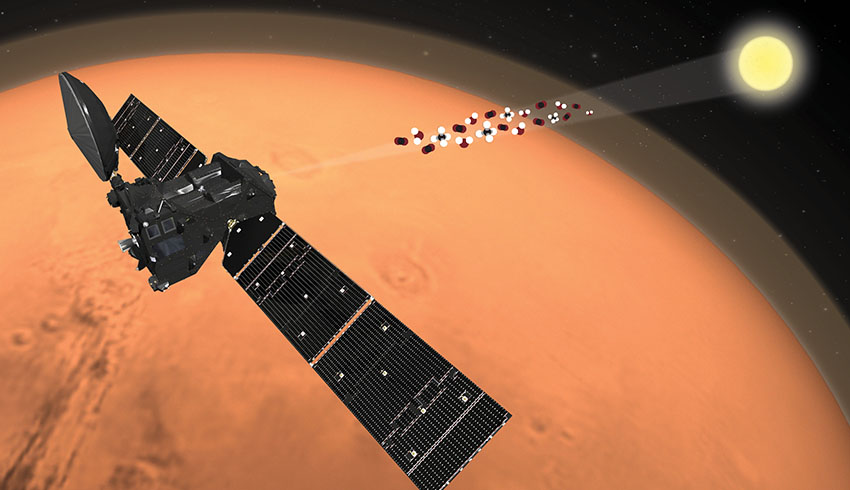
Navigators today tell a spacecraft where to go by calculating its position from Earth and sending the location data to space in a two-way relay system that can take anywhere from minutes to hours to deliver directions. This method of navigation means that no matter how far a mission travels through the solar system, spacecraft are still tethered to the ground, waiting for commands from our planet.
That limitation poses obvious problems for a future crewed mission to another planet. How can astronauts navigate far from Earth if they don't have immediate control over where they're going? And how can they accurately land on another planet when there's a communication delay that affects how quickly they can adjust their trajectory into the atmosphere?
NASA's Deep Space Atomic Clock is a toaster-size device that aims to answer those questions. It's the first GPS-like instrument small and stable enough to fly on a spacecraft. The technology demonstration enables the spacecraft to know where it is without needing to rely on that data from Earth. In late June, the clock will launch on the SpaceX Falcon Heavy rocket into Earth's orbit for one year, where it will test whether it can help spacecraft locate themselves in space.
If the Deep Space Atomic Clock's trial year in space goes well, it could pave the way for a future of one-way navigation in which astronauts are guided by a GPS-like system across the surface of the moon or can safely fly their own missions to Mars and beyond.
Jill Seubert, the deputy principal investigator, said, "Every spacecraft exploring deep space is steered by navigators here on Earth. Deep Space Atomic Clock will change that by enabling onboard autonomous navigation, or self-driving spacecraft."
Atomic clocks in space aren't new. Every GPS device and smartphone determines its location via atomic clocks on satellites orbiting Earth. The satellites send signals from space, and the receiver triangulates your position by measuring how long the signals take to reach your GPS.
Currently, spacecraft flying beyond Earth's orbit don't have a GPS to find their way through space. Atomic clocks on GPS satellites aren't accurate enough to send directions to spacecraft, when being off by even less than a second could mean missing a planet by miles.
Instead, navigators use giant antennas on Earth to send a signal to the spacecraft, which bounces it back to Earth. Extremely precise clocks on the ground measure how long it takes the signal to make this two-way journey. The amount of time tells them how far away the spacecraft is and how fast it is going. Only then can navigators send directions to the spacecraft, telling it where to go.
"It's the same exact concept as an echo. If I'm standing in front of a mountain and I shout, the longer it takes for the echo to come back to me, the farther away the mountain is," explained Seubert.
Two-way navigation means that no matter how deep into space a mission goes, it still has to wait for a signal carrying commands to cross the vast distances between planets. It's a process made famous by Mars landings like Curiosity, when the world waited 14 long minutes with mission control for the rover to send the message that it landed safely.
That delay is an average wait time: Depending on where Earth and Mars are in their orbits, it can take anywhere from four to 20 minutes for a one-way signal to travel between planets.
"Having a clock onboard would enable onboard radio navigation and, when combined with optical navigation, make for a more accurate and safe way for astronauts to be able to navigate themselves," explained Deep Space Atomic Clock principal investigator Todd Ely.
Eric Burt, the ion clock development lead, and fellow JPL clock physicists Robert Tjoelker and John Prestage created a mercury ion clock, which maintains its stability in space in the same way as refrigerator-size atomic clocks on Earth. In lab tests, the Deep Space Atomic Clock proved to be 50 times more accurate than GPS clocks. That's an error of 1 second every 10 million years.
The clock's demonstration in space will determine whether it can remain stable in orbit. If it does, a Deep Space Atomic Clock could fly on a mission as early as the 2030s. The first step towards self-driving spacecraft that could one day carry humans to other worlds.
The Deep Space Atomic Clock is hosted on a spacecraft provided by General Atomics Electromagnetic Systems of Englewood, Colorado. It is sponsored by the Technology Demonstration Missions program within NASA's Space Technology Mission Directorate and the Space Communications and Navigations program within NASA's Human Exploration and Operations Mission Directorate. JPL manages the project.
Receive the latest developments and updates on Australia’s space industry direct to your inbox. Subscribe today to Space Connect here.









